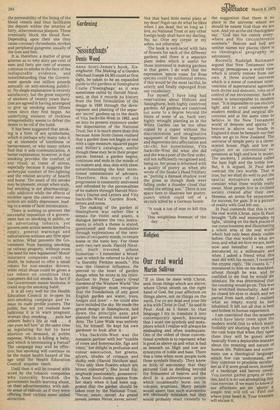Religion
Our real world
Martin Sullivan
"If ye then be risen with Christ, seek those things which are above, where Christ sitteth on the right hand of God. Set your affection on things above, not on things on the earth. For ye are dead and your life is his with Christ in God." So said St Paul. And as I listen to that language I try to translate it into contemporary speech, knowing that 1 must use symbols and metaphors which I realise will always be misleading and often inadequate. One of the oldest of these conventional symbols is to represent what is good as above us and what is bad as beneath us. High and low are synonyms of noble and base. There was a time when most people took these symbols literally. They knew so little of astronomy that they pictured God as dwelling beyond the firmament of heaven and the devil in a subterranean prison which occasionally burst out in volcanic eruptions. Many people would assert that such statements are obviously mistaken but they would probably react violently to the suggestion that there is no place in the universe where we should be nearer God than we are now. And yet as the old theologians say, "God has his centre every where and His circumference nowhere." Heaven and hell are neither names nor places; there is no theological geography or astronomy. Recently Rudolph Bultmann argued that New Testament cos mology presupposes a world view which is utterly remote from our own. A three storied universe which is a scene of constant inter ventions of supernatural agencies, both divine and demonic, robs us of control of our environment. Such a notion is unacceptable to modern man. "It is impossible to use electric light and to avail ourselves of modern medical and surgical discoveries and at the same time to believe in the New Testament world of demons and spirits." If heaven is above our heads in England it must be beneath our feet when we go to New Zealand. The universe of simple piety is a three storied house. High and low in religion are as conventional expressions as high and low in music. The ancients, I understand called the bass high and the treble low. But, it is argued, St Paul does contrast the two worlds. That is true, but we shall do well to put the spatial metaphors aside and consider what these worlds really mean. Most people live in civilised society created after their own likeness, an arena for enjoyment, for success, for gain. It is a picture of reality with God left out. St Paul contends that this is not the real world. Christ, says St Paul, brought "Life and immortality to light," shining on the dark places of our consciousness and illuminating a whole area of the real world which had only been dimly visible before. Our real world is what we love, and what we love we are, both now and hereafter. I was once introduced to a millionaire and when I asked a friend what this man did with his money, I received the cryptic reply, "He counts it." I ministered to him on his deathbed, atheist though he was, and he confided to me that he would die intestate. He was determined that the counting would go on. This was his wretched immortality. And as
he closed his eyes in death and we parted from each other I realised what an empty world he had inhabited. It left out all that is best and holiest in human experience.
I am convinced that the miseries which have lately come upon the
modern world (but to which many.
foolishly are shutting their eyes in the vain hope that when they open them they will be gone) arise basically from a deplorable mistake about the meaning and nature of human life. Politicians and economists use a theological language which few can understand, and they continue to proclaim secularism as if it were good news, instead of a bankrupt and barren creed. You cannot gather grapes or thistles, and it is no use attempting this vain exercise. If we want to know if our affections are set 'above' a simple test will tell us. Find out where your heart is. Your treasure will encase it.










































 Previous page
Previous page